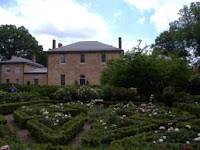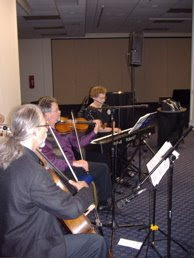It’s an interesting phenomenon that the closer you live to a historic site, the less likely you are to visit it. I had dinner last night with Diane and Amanda and our conversation included a joint confession from me and Diane about all the places we hadn’t been to in the Washington DC area. We also exchanged ideas on time management but I fear we only encouraged each other on new ways to procrastinate.
Last Saturday I took time off from writing by visiting Tudor Place with my friend and fieldtrip companion Kate Dolan. I’d never visited (of course), although it has a family connection via the Custis and Calvert families to Riversdale House Museum (which I visit fairly often as I’m a docent). Also I wanted to check it out as the Beau Monde field trip on July 15 includes visits to both locations. And if you’re a member of the Beau Monde, you’ll hear about it soon. Honest!
 So, the house. Absolutely gorgeous. It was built by Martha Washington’s granddaughter and her husband, Martha Custis Peter and Thomas Peter, on land acquired in 1805, and designed by Dr. William Thornton, architect of the US Capitol. Construction ended in 1816 and the Peter family lived in the house until 1983. Consequently it is a house filled with almost two centuries’ worth of art and artefacts collected by the family, several of whom were amateur artists (quite good ones). It also has a superb garden.
So, the house. Absolutely gorgeous. It was built by Martha Washington’s granddaughter and her husband, Martha Custis Peter and Thomas Peter, on land acquired in 1805, and designed by Dr. William Thornton, architect of the US Capitol. Construction ended in 1816 and the Peter family lived in the house until 1983. Consequently it is a house filled with almost two centuries’ worth of art and artefacts collected by the family, several of whom were amateur artists (quite good ones). It also has a superb garden.
This palm tree outside the house is one of several that are third-generation descendants of trees acquired by the Peters almost two centuries ago.
 The house isn’t built of stone, as you might think, but stucco scored to look like it over brick construction. Photography was not allowed inside the house, but one of the highlights for me was seeing the original 1920s kitchen with original fittings including a mighty iron range and hot water heater. There’s also a very lovely butler’s pantry with many sets of china–because the family were in the house so long each new bride brought new china to the house.
The house isn’t built of stone, as you might think, but stucco scored to look like it over brick construction. Photography was not allowed inside the house, but one of the highlights for me was seeing the original 1920s kitchen with original fittings including a mighty iron range and hot water heater. There’s also a very lovely butler’s pantry with many sets of china–because the family were in the house so long each new bride brought new china to the house.
The house is also particularly rich in items owned by George Washington, including china and silver. Moreover, since this was a family who didn’t throw anything away, ever, there’s a terrific amount of documentation in the form of bills, letters and so on. Many major historical figures were entertained at the house including Lafayette and Daniel Webster.

 I was lucky enough to visit at peak rose blooming season, which was spectacular this year because it’s been cool and wet. The garden has many varieties of heirloom roses, many beautifully scented; and with a wide variety of scents, too–peppery, spicey and so on. The roses on the left are from the early nineteenth century–early varieties tend to be rather straggly with small blooms, and this one is unusual in that it blooms all summer (or as long as it can stand to in DC). The one on the right–oh, it’s a nice (if off-center) picture. I think it’s probably a variety from later in the century. By July most of these roses will probably have given up the fight against the heat so I was glad to see them and take these pics.
I was lucky enough to visit at peak rose blooming season, which was spectacular this year because it’s been cool and wet. The garden has many varieties of heirloom roses, many beautifully scented; and with a wide variety of scents, too–peppery, spicey and so on. The roses on the left are from the early nineteenth century–early varieties tend to be rather straggly with small blooms, and this one is unusual in that it blooms all summer (or as long as it can stand to in DC). The one on the right–oh, it’s a nice (if off-center) picture. I think it’s probably a variety from later in the century. By July most of these roses will probably have given up the fight against the heat so I was glad to see them and take these pics.

 Here’s an overview of the gardens and a closeup of some foxgloves, which to my surprise grew in full sun among the roses and seemed quite happy there.
Here’s an overview of the gardens and a closeup of some foxgloves, which to my surprise grew in full sun among the roses and seemed quite happy there.

 Here’s a very lovely rose arbor and a close up of the roses growing on it. On the left you can also see some of the gigantic boxwoods in the garden. There were also some huge trees that may have been original to the garden and although I briefly met the garden specialist I didn’t have time to bombard her with as many questions as I would have liked.
Here’s a very lovely rose arbor and a close up of the roses growing on it. On the left you can also see some of the gigantic boxwoods in the garden. There were also some huge trees that may have been original to the garden and although I briefly met the garden specialist I didn’t have time to bombard her with as many questions as I would have liked.
So this seems as good a time as any to ask the question: What are you doing this summer? Are you coming to the RWA National Conference in Washington, DC?–and I’ve just heard that I’ll be signing A Most Lamentable Comedy at the July 15 “Readers for Life” Literacy Autographing, which I’m very excited about. Are you planning a vacation? Where? What will your beach reads be?
 Greetings from the nation’s capital (except I’m almost always here), and here’s what we’ve been up to.
Greetings from the nation’s capital (except I’m almost always here), and here’s what we’ve been up to. In the evening, live dancing, live music, a new battery for the camera and an open bar at the Beau Monde soiree–what could be better?
In the evening, live dancing, live music, a new battery for the camera and an open bar at the Beau Monde soiree–what could be better? Once again we demonstrated our complete incompetence on the dance floor, although by the end of the evening we were improving noticeably. Diane’s here next to one of the very glamorous M&B editors in her killer heels.
Once again we demonstrated our complete incompetence on the dance floor, although by the end of the evening we were improving noticeably. Diane’s here next to one of the very glamorous M&B editors in her killer heels.








